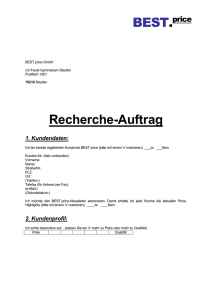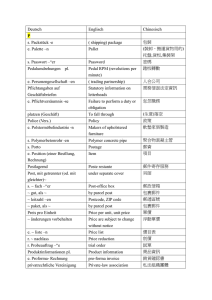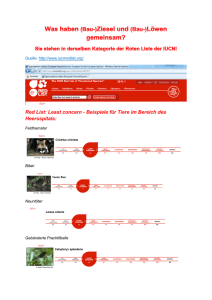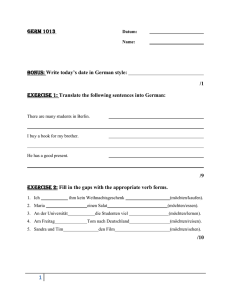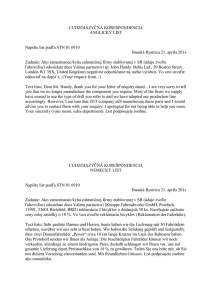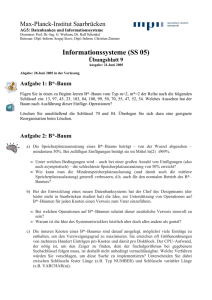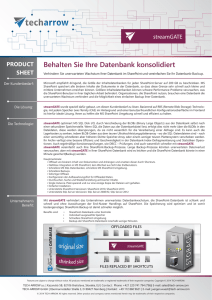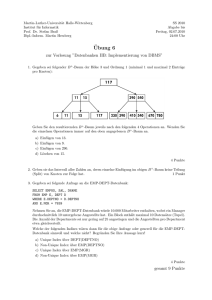Assignment 14
Werbung
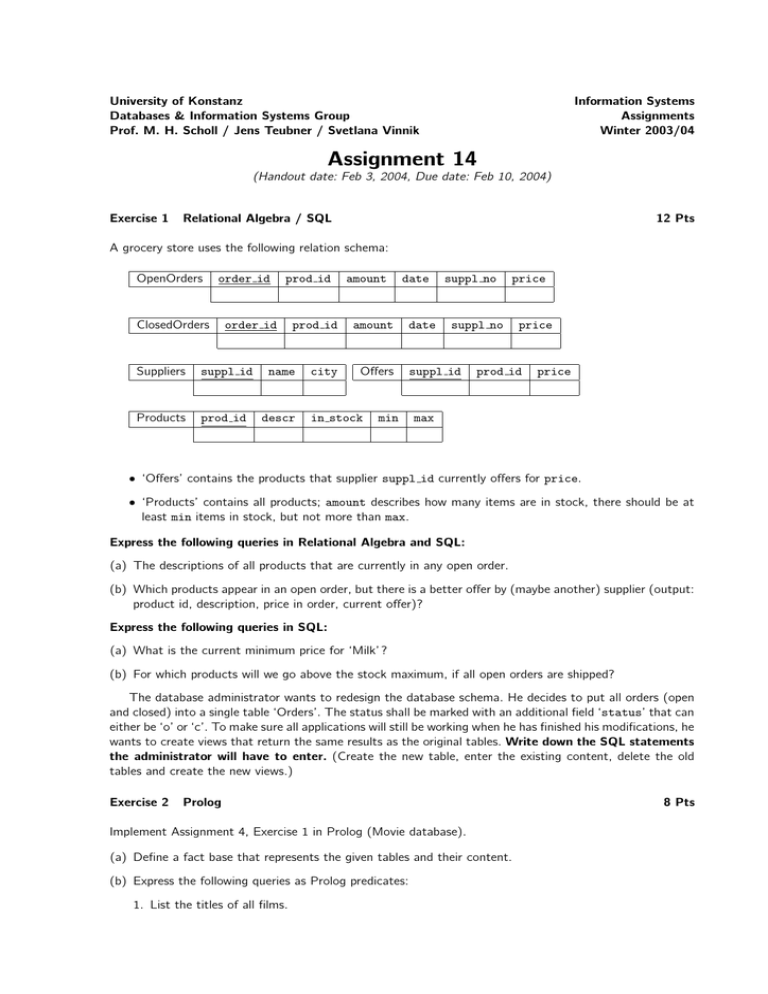
University of Konstanz Databases & Information Systems Group Prof. M. H. Scholl / Jens Teubner / Svetlana Vinnik Information Systems Assignments Winter 2003/04 Assignment 14 (Handout date: Feb 3, 2004, Due date: Feb 10, 2004) Exercise 1 Relational Algebra / SQL 12 Pts A grocery store uses the following relation schema: OpenOrders order id ClosedOrders prod id order id prod id Suppliers suppl id name Products prod id descr city amount date amount Offers in stock min date suppl no price suppl no suppl id price prod id price max • ‘Offers’ contains the products that supplier suppl id currently offers for price. • ‘Products’ contains all products; amount describes how many items are in stock, there should be at least min items in stock, but not more than max. Express the following queries in Relational Algebra and SQL: (a) The descriptions of all products that are currently in any open order. (b) Which products appear in an open order, but there is a better offer by (maybe another) supplier (output: product id, description, price in order, current offer)? Express the following queries in SQL: (a) What is the current minimum price for ‘Milk’ ? (b) For which products will we go above the stock maximum, if all open orders are shipped? The database administrator wants to redesign the database schema. He decides to put all orders (open and closed) into a single table ‘Orders’. The status shall be marked with an additional field ‘status’ that can either be ‘o’ or ‘c’. To make sure all applications will still be working when he has finished his modifications, he wants to create views that return the same results as the original tables. Write down the SQL statements the administrator will have to enter. (Create the new table, enter the existing content, delete the old tables and create the new views.) Exercise 2 Prolog Implement Assignment 4, Exercise 1 in Prolog (Movie database). (a) Define a fact base that represents the given tables and their content. (b) Express the following queries as Prolog predicates: 1. List the titles of all films. 8 Pts 2. List the names of all female actresses. 3. Which actors/actresses starred in ‘Bourne Identity, The’ ? List their names. 4. List the titles of all films with female roles. 5. List the titles of all films with no female roles. 6. List the names of all actors/actresses that played together with ‘Grant, Hugh’ in any film. Exercise 3 B+-Indexstrukturen (Extra-Aufgabe ohne Wertung) Fahrer fahrer id 15 6 10 3 9 2 4 17 name Antonio Pizzonia Kimi Räikkönen Heinz-Harald Frentzen Juan Pablo Montoya Nick Heidfeld Rubens Baricello Ralf Schumacher Jacques Villeneuve team Jaguar-Racing McLaren-Mercedes Sauber-Petronas Williams-BMW Sauber-Petronas Ferrari Williams-BMW BAR-Honda 0 Pts nation Brasilien Finnland Deutschland Kolumbien Deutschland Brasilien Deutschland Kanada Der Betreiber einer Formel-Eins-Informationsseite im Internet will die Daten aller Fahrer erfassen. Ein Praktikant gibt die obige Liste in das Datenbanksystem ein. Das Datenbanksystem verwendet zur Indizierung des Attributs fahrer id einen B+-Baum der Ordnung 1 (2 Schlüsselwerte je Knoten; Fan-out: 3). Nachdem der Praktikant die ersten drei Tupel eingegeben hat, sieht der B+-Baum wie folgt aus: 10 6 10 15 Der Praktikant gibt nun die restlichen Tupel in die Datenbank in der obigen Reihenfolge von oben nach unten ein (also beginnend mit ‘Juan Pablo Montoya’). (a) Wie sieht der B+-Baum nach jedem einzelnen Schritt aus wenn die Tupel weiter eingegeben werden? Kommt es zum Split eines Knoten, verhält sich der B+-Baum so, wie in der Vorlesung angegeben: d. h. die jeweils größere Hälfte“ wandert in den rechten Knoten. Redistribution kennt das Datenbanksystem nicht. ” (b) Schätzen Sie für B+- und Hash-Index den Aufwand in Anzahl Seitenzugriffen ab, der für eine große Anzahl Datensätze n für das Auffinden eines Tupels notwendig ist. Wie groß ist der Aufwand im Regelfall, wie können sich ungünstig verteilte Daten auswirken? (c) Beim erstmaligen Laden von großen Tabellen (“Bulk Loading”) liegen die Quelldaten oft bereits vorsortiert vor. Welche Nachteile entstehen, wenn beim Ladevorgang der normale Einfüge-Algorithmus verwendet wird? Wie könnte man einen Bulk-Loading-Algorithmus konzipieren, der diese Nachteile behebt (und natürlich nur mit vorsortierten Daten funktioniert)?
